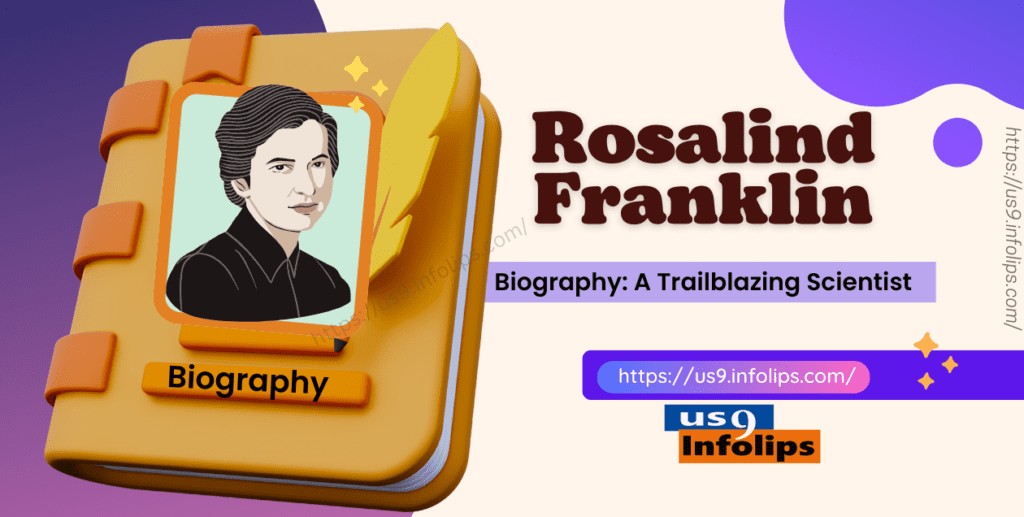Rosalind Franklin Biography : A Trailblazing Scientist – Perfect Info
Rosalind Franklin Biography: A Trailblazing Scientist
Rosalind Franklin was a pioneering scientist whose work in X-ray crystallography was crucial in discovering the DNA double-helix structure. Despite facing challenges in a male-dominated scientific community, her contributions to molecular biology have left an enduring legacy.
This article explores the key milestones in her life, the controversies surrounding her work, and the impact she had on science and future generations.
Table of Contents
1. Early Life and Education:
Rosalind Franklin was born on July 25, 1920, in London, England. She was raised in a wealthy and educated family that encouraged her curiosity and love for learning. From a young age, Rosalind was interested in science and excelled in her studies.
She attended St. Paul’s Girls’ School, where she showed great aptitude in physics and chemistry.
2. University Education
In 1938, Franklin enrolled at Newnham College, Cambridge, to study chemistry. Her time at Cambridge was marked by academic excellence, and she earned her degree in 1941. She then went on to conduct research for a doctorate in physical chemistry, working under the supervision of Ronald Norrish, a Nobel Prize-winning chemist.
3. World War II Contribution
During World War II, Franklin contributed to the war effort by working at the British Coal Utilization Research Association. Here, she conducted important research on the physical structure of coal and graphite, which later became the basis of her PhD thesis.
Post-War Career in Paris
After earning her PhD in 1945, Franklin moved to Paris to work at the Laboratoire Central des Services Chimiques de l’État. In Paris, she learned X-ray diffraction techniques from Jacques Mering, a skill that would become crucial in her later work. This experience ignited her passion for using X-ray crystallography to understand the structure of matter.
4. Return to London and King’s College
In 1951, Franklin returned to London and joined King’s College as a research associate. At King’s, she worked in the biophysics unit, where her focus was on studying the structure of DNA using X-ray diffraction. This period marked the beginning of her most significant scientific contributions.
5. Pioneering Work on DNA
Rosalind Franklin’s meticulous X-ray diffraction images of DNA were critical in revealing its double-helix structure. Her famous “Photo 51” provided key insights that led James Watson and Francis Crick to develop their groundbreaking model of DNA. However, her contributions were not fully recognized during her lifetime.
6. Further Research and Achievements
After her work on DNA, Franklin continued her research on the structure of viruses. In 1953, she moved to Birkbeck College, where she led a team studying the tobacco mosaic virus. Her work significantly advanced the understanding of the molecular structures of viruses.
7. Challenges and Legacy
Throughout her career, Franklin faced numerous challenges, including gender bias and lack of recognition for her contributions. Despite these obstacles, she remained dedicated to her research and made significant scientific advancements that laid the groundwork for future discoveries.
8. Untimely Death:
Rosalind Franklin’s life was tragically cut short when she died of ovarian cancer on April 16, 1958, at the age of 37. Her early death prevented her from seeing the full impact of her contributions to science.
9. Posthumous Recognition
Although Franklin did not receive the recognition she deserved during her lifetime, her legacy has since been celebrated and honored. Her pioneering work in X-ray crystallography and her vital role in discovering the DNA structure have cemented her place as a trailblazing scientist who broke barriers and paved the way for future generations of researchers.
So this was the brief Rosalind Franklin Biography.
Facts About Rosalind Franklin
1. Birth and Family Background:
Rosalind Franklin was born on July 25, 1920, in London, England, into a well-educated and wealthy Jewish family.
2. Education:
She attended St. Paul’s Girls’ School in London, one of the few schools at the time that taught physics and chemistry to girls.
3. University Studies:
Franklin studied chemistry at Newnham College, Cambridge, and graduated in 1941. She earned her PhD in physical chemistry in 1945.
4. War-Time Research:
During World War II, she worked on coal and carbon at the British Coal Utilization Research Association, which helped her develop expertise in X-ray diffraction techniques.
5. Paris Experience:
In 1947, she moved to Paris and worked at the Laboratoire Central des Services Chimiques de l’État, where she became an expert in X-ray crystallography.
6. King’s College London:
In 1951, Franklin joined King’s College London, where she conducted pioneering research on the structure of DNA using X-ray diffraction.
7. DNA Work:
Her X-ray diffraction image of DNA, known as “Photo 51,” was crucial in discovering the double-helix structure of DNA.
8. Move to Birkbeck College:
In 1953, Franklin moved to Birkbeck College, where she led a team researching the tobacco mosaic virus.
9. Death:
She died of ovarian cancer on April 16, 1958, at the age of 37, cutting short a promising scientific career.
9 Best Achievements in Rosalind Franklin’s Life
1. X-ray Crystallography Expertise:
Franklin became one of the leading experts in X-ray crystallography, a key technique for studying molecular structures.
2. Coal Research:
Her work on the porosity of coal led to improved gas masks during World War II and contributed to her PhD thesis.
3. DNA Structure Discovery:
Her meticulous research and X-ray diffraction images were critical to understanding the structure of DNA, laying the groundwork for the double-helix model.
4. Photo 51:
This iconic image was instrumental in the discovery of DNA’s structure, providing vital information about the helical form.
5. Virus Structure Research:
Franklin made significant contributions to understanding the molecular structures of viruses, particularly the tobacco mosaic virus.
6. Published Papers:
She published numerous scientific papers on the structure of coal, DNA, and viruses, showcasing her breadth of knowledge and expertise.
7. Pioneering Woman in Science:
Franklin broke barriers for women in science, achieving significant accomplishments in a male-dominated field.
8. Influence on Molecular Biology:
Her work influenced the field of molecular biology, paving the way for future research and discoveries.
9. Legacy and Recognition:
Despite initial lack of recognition, her contributions to science have been widely acknowledged posthumously, and she is celebrated as a pioneering scientist.
9 Unknown Facts About Rosalind Franklin
1. Childhood Interest in Science:
From a young age, Franklin showed a keen interest in science, conducting her own experiments at home.
2. Athletic Abilities:
She was an avid athlete, excelling in rowing, cycling, and mountain climbing.
3. Fluent in French:
Franklin was fluent in French, which helped her during her research stint in Paris.
4. Artistic Talent:
She had a talent for drawing and painting, often sketching landscapes during her travels.
5. Family Support:
Despite societal norms, Franklin’s family strongly supported her pursuit of a career in science.
6. Close Friendships:
Franklin formed close friendships with fellow scientists and colleagues, including Anne Sayre, who later wrote a biography to highlight her contributions.
7. Private Nature:
She was known for her private and reserved personality, focusing intensely on her work.
8. Posthumous Recognition:
Franklin did not receive the Nobel Prize with Watson, Crick, and Wilkins in 1962 because the Nobel Committee does not award prizes posthumously.
9. Impact on Future Research:
Her research methods and findings continue to influence scientific research, especially in structural biology and genetics.
9 Controversies About Rosalind Franklin
1. DNA Structure Credit:
The most notable controversy involves the credit for discovering the structure of DNA. Franklin’s critical contributions were overshadowed by James Watson and Francis Crick, who used her data (specifically “Photo 51”) without her direct permission to construct their DNA model.
2. Misunderstanding with Maurice Wilkins:
Franklin had a strained relationship with Maurice Wilkins, her colleague at King’s College London. They initially misunderstood each other’s roles, which led to tension and communication issues that impacted their collaboration.
3. Publication Timing:
Franklin’s own research on the structure of DNA was published in the same issue of Nature as Watson and Crick’s paper, but her findings were presented as supporting evidence rather than as a primary discovery.
4. Gender Bias:
Franklin faced gender discrimination throughout her career, which hindered her recognition and opportunities in the male-dominated scientific community.
5. Work Environment at King’s College:
The male-dominated environment at King’s College often excluded Franklin from informal discussions and collaborations that could have furthered her work.
6. Data Sharing:
There was a lack of communication regarding data sharing at King’s College, leading to her findings being used without her direct consent or acknowledgment.
7. Misrepresentation in Literature:
In James Watson’s book, The Double Helix, Franklin was portrayed in a negative light, which distorted the public’s understanding of her contributions and personality.
8. Delayed Recognition:
Despite her groundbreaking work, Franklin was not nominated for a Nobel Prize, partly because the significance of her contributions was not fully recognized during her lifetime.
9. Legacy Debate:
Debates continue about how Franklin should be credited in the context of DNA’s discovery, with ongoing discussions about the extent to which her male colleagues benefited from her data.
9 Best Social Works by Rosalind Franklin
1. Encouragement of Women in Science:
Although not formally recognized as social work, Franklin’s career and achievements inspired future generations of women to pursue careers in science and technology.
2. Mentorship:
Franklin actively mentored young scientists, including women, at Birkbeck College, supporting their development and encouraging them to pursue scientific careers.
3. Scientific Collaboration:
She believed in the importance of collaboration and shared her knowledge freely with her peers, which contributed to advancements in multiple scientific fields.
4. Contribution to Medicine:
Her research on viruses, including the tobacco mosaic virus, laid the groundwork for future developments in virology and medicine, indirectly benefiting public health.
5. Research for Public Good:
Franklin’s work on coal and carbon during World War II contributed to the war effort by improving gas masks, demonstrating her commitment to applying science for societal benefit.
6. Support for Students:
Franklin was known for her support of students and younger colleagues, providing guidance and encouragement to those embarking on scientific careers.
7. Advocacy for Equal Opportunities:
While Franklin did not openly campaign for women’s rights, her achievements in a male-dominated field highlighted the need for equal opportunities for women in science.
8. Community Engagement:
Franklin engaged with scientific communities across Europe, fostering international cooperation and exchange of knowledge.
9. Scientific Integrity:
Her dedication to rigorous scientific research and integrity set an example for ethical scientific conduct, influencing future standards in research.
Conclusion
Rosalind Franklin was a pioneering scientist whose groundbreaking work in X-ray crystallography laid the foundation for understanding the structure of DNA, one of the most significant scientific discoveries of the 20th century.
Despite facing gender bias and challenges within the scientific community, her contributions have had a lasting impact on molecular biology and genetics. While her achievements were not fully recognized during her lifetime, Franklin’s legacy continues to inspire scientists around the world.
Her dedication to scientific integrity and her role in advancing our understanding of the natural world underscore the importance of acknowledging the contributions of all scientists, regardless of gender or background.
FAQs
Q.1: What is Rosalind Franklin best known for?
A: She is best known for her X-ray diffraction work that contributed to the discovery of the DNA double-helix structure.
Q.2: Did Rosalind Franklin win a Nobel Prize?
A: No, she did not receive a Nobel Prize. The Nobel Prize was awarded to Watson, Crick, and Wilkins in 1962, after her death.
Q.3: What was “Photo 51”?
A: “Photo 51” was an X-ray diffraction image of DNA that was critical in revealing the DNA double-helix structure.
Q.4: What challenges did Franklin face in her career?
A: Franklin faced gender bias, lack of recognition, and a challenging work environment at King’s College, which affected her collaborations and acknowledgment.
Q.5: How did Rosalind Franklin contribute to virology?
A: She conducted significant research on the tobacco mosaic virus, advancing the understanding of viral structures.
Q.6: Where did Rosalind Franklin receive her education?
A: She studied chemistry at Newnham College, Cambridge, and completed her PhD in physical chemistry in 1945.
Q.7: What was the controversy surrounding her DNA research?
A: The controversy involved the use of her data by Watson and Crick without her explicit permission to develop their DNA model.
Q.8: How did Franklin inspire future generations?
A: Her achievements in a male-dominated field and her mentorship of young scientists have inspired many women to pursue careers in science.
Q.9: What legacy did Rosalind Franklin leave behind?
A: Franklin’s legacy includes her groundbreaking contributions to molecular biology and her role as a trailblazer for women in science.
Follow us for more captivating articles and stay connected to explore the world. Let’s embrace the power of communication and understanding.
Disclaimer: The views in this article are given with the help of information available on the net. Readers are encouraged to conduct their own research before making any decisions. The publisher disclaim any liability for any loss or damage caused directly or indirectly.

Related topics:
1. Perfect World Travel Guide
2. 9 Most Popular EV Cars in the USA
3. 9 Best Things About Apple TV 4K – Third Generation
4. Think before You Renew Amazon Prime
5. Jimmy Carter: A Great Legacy
6. Memorial Day: Honoring the Sacrifice, Celebrating Freedom
School Site :
For English grammar and lot more : Smart School Infolips
Marathi Poems: Marathi Rang












